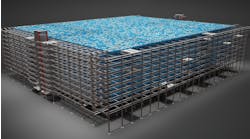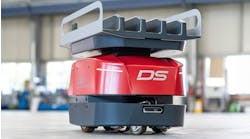The COVID-19 pandemic has upended how and where we work. A year and a half into this massive shift, productivity has not fallen and with the right technology, has the potential to grow. This extends to jobs on the plant floor that even a few years ago, would have been impossible to perform remotely. The IT/OT convergence has transformed the plant floor, allowing for remote access and control. However, like many other industries, companies are struggling to find people with the right skillsets to manage not only new technologies but also new security threats.
Many companies have talented IT and OT teams in place. But few have IT/OT specialists, a role that is tricky to fill, but with remote access as a tool, broadens the pool of potential applicants to anywhere with a reliable internet connection. These are experts who merge OT application knowledge with technology typically used in IT roles. They have the right blend of skills and knowledge to help realize the potential of digitalized production operations while avoiding issues that can cause costly downtime.
The need for these specialists has been especially apparent over the last 18 months. With COVID-19 forcing people out of plants, reliable remote plant access has been the path forward. In this same period, we have seen a new surge of ransomware attacks across industries. These attacks and other threats targeting the plant floor also continue to emerge, and traditional IT security tools and skillsets alone aren’t enough to combat them in dynamic plant environments.
Where Can Remote Managed Services Help the Most?
In areas where IT assets play a prominent role, like your connected application assets, plant networks, firewalls, and data centers hosting manufacturing software, remote managed services can provide support. Remote-managed services combine support components like domain expertise, technology, remote connectivity, and monitoring.
Most importantly, remote-managed services can help drive the production outcomes that matter most to you, like improving asset utilization and minimizing downtime. To understand how, let’s look at three common needs in plants where remote-managed services can help.
1. Securing Operations
Plant floors are dynamic and complex so a comprehensive approach to cybersecurity is needed to help protect them. It can be difficult to know where to even begin securing your plant floor. With remote-managed services, you can get the support you need to ensure your infrastructure is secure, robust, and reliable.
This includes providing the domain expertise and monitoring capabilities needed to maintain a high level of availability by monitoring an appliance on your behalf and providing remote administration. Remote service providers can maintain key pieces of your infrastructure, like firewall appliances that must be kept up to date and in continual operation to maintain a high-order security posture.
Managing enterprise risk with active threat detection management is another way remote providers can add value. This can help maintain compliance and greater business continuity and involves identifying normal network behavior, continuously monitoring for activity that does not conform to that expected baseline, and alerting you of suspicious behavior. This may even make it easier to deploy threat detection across several dozen sites, giving better visibility into OT assets and detecting anomalies and vulnerabilities in real time.
2. Implementing Remote Access
The pandemic forced the hand of many enterprises into giving employees, partners, and vendors remote access to plants. A year and a half into this new normal and remote access has become the new standard. Remote access has revealed new efficiencies and lower-cost plant support.
In addition to launching, managing, and maintaining secure remote access to plants, a service provider can manage key aspects of remote connections, like user logins, and can help make sure the connections are authorized, such as by using multi-factor authentication and integrating with Windows Active Directory for user authorization.
Another option is to implement remote access solely for monitoring plant applications by a remote support team. The team can monitor hundreds or thousands of data points across a plant, and either address issues remotely or notify on-site personnel to address them. This can help you reduce downtime and fill a critical need if you’re struggling to fill maintenance roles locally.
Software used for changeovers is as integral to production as the machine and must be properly managed to avoid downtime.
Implementing remote access also offers the opportunity to reimagine work across your plants by combining new technologies. For example, some companies are using augmented reality tools to connect remote SMEs with plant personnel to see and solve problems almost as if they were there in person. Others are combining remote support centers with artificial intelligence to proactively monitor the health of equipment around the world and get ahead of costly failures.
3. Maintaining Virtualized Operations
Manufacturers are using virtualization to operate with more efficiency, flexibility, and cost-effectiveness. They’re virtualizing manufacturing outcomes, like batch management and process visualization, as well as processes themselves, like the reconfiguring of machines for new product runs. But as these things move from the OT space into the IT/OT space, new skillsets are needed.
Virtualization also has the potential to reduce non-productive time in new and creative ways. Imagine connecting your plants to your OEMs to perform virtual factory acceptance tests for new machines while they’re still on the OEM’s shop floor. This could allow machines to start running almost immediately after they’re delivered onsite.
An Extension of Your Team
Remote-managed services are one way to realize the promise of IT/OT convergence and reduce risk to your business. They can deliver the capabilities and resources you need to deploy, monitor, and manage key aspects of your virtualized plant operations.
COVID-19 has exacerbated skills shortages and cybersecurity risks continue to grow across the sector and these aren’t the only challenges you face as you try to create smarter, more connected plants. You may also be contending with aging equipment, a brain drain as older workers retire, greater pressures to improve productivity, and new environmental regulations and mandates.
Remote-managed services can help you address these challenges by supplementing your team, creating more efficiencies, and taking on some of your biggest technology-related challenges, so your people can focus on doing what they do best.











